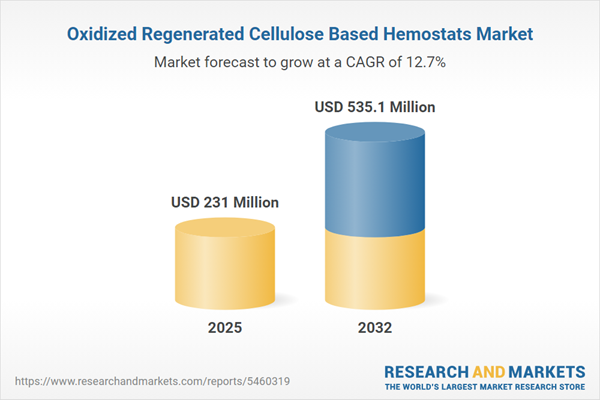Speak directly to the analyst to clarify any post sales queries you may have.
Senior healthcare decision-makers navigating the oxidized regenerated cellulose based hemostats market encounter an evolving landscape shaped by innovation, compliance demands, and the need for operational resilience. This report provides a clear, strategic overview for organizations prioritizing procurement flexibility, robust clinical protocols, and adaptive delivery in surgical care.
Market Snapshot: Oxidized Regenerated Cellulose Based Hemostats Market
The oxidized regenerated cellulose based hemostats market is characterized by steady, sustainable growth, supported by ongoing product innovation and broadening adoption in diverse surgical specialties. Both established medical device suppliers and new entrants are shaping the market by introducing solutions tailored for the specialized procedural needs of hospitals and surgical centers. Digital workflow integration has become pivotal, enabling clinical teams to manage the increasing complexity of surgical cases. As regulatory frameworks grow more stringent, organizations refine risk management and safeguard quality standards. The sector remains highly responsive to advancements in healthcare technology, emerging compliance requirements, and evolving supply chain expectations, fostering consistent surgical outcomes in a changing environment.
Scope & Segmentation
This report offers actionable segmentation for senior leadership to guide procurement and operations within the oxidized regenerated cellulose based hemostats market:
- Product Types: Film, foam, gauze, and powder options equip clinicians to tailor hemostatic solutions for a range of surgical and patient needs. Each type addresses specific procedural demands, supporting both routine and complex interventions across facilities.
- Sales Channels: Direct manufacturer engagement, offline distribution partnerships, digital procurement platforms, and hybrid sourcing structures provide organizations with options to sustain agile supply and inventory management.
- Applications: Cardiovascular, orthopedic, general, dental, urology, gynecology, ENT, and trauma surgery applications highlight the extensive multidisciplinary utility of these hemostats and support alignment with integrated care pathways.
- End Users: Ambulatory surgical centers, outpatient clinics, specialty facilities, and expansive health systems rely on product consistency to achieve operational continuity and uphold patient care quality.
- Regions: The Americas, Europe, Middle East, Africa, and Asia-Pacific represent regions where market dynamics vary due to differences in infrastructure, regulatory environments, and healthcare investment priorities.
- Key Companies: Strategic profiles are provided for Johnson & Johnson, Medtronic plc, Baxter International Inc., 3M Company, B. Braun Melsungen AG, Becton, Dickinson and Company, Stryker Corporation, Teleflex Incorporated, Integra LifeSciences Holdings Corporation, and CryoLife, Inc., reflecting a spectrum of technology integration and engagement in the sector.
Key Takeaways for Senior Decision-Makers
- Adoption of oxidized regenerated cellulose based hemostats elevates organizational adaptability, supporting teams in responding to continuously evolving workflows and compliance expectations.
- Material and delivery advancements enable these hemostats to address discipline-specific challenges and streamline the management of complex surgical scenarios.
- Specialized inventory management solutions provide actionable oversight into supply chain operations, safeguarding regulatory alignment and operational efficiency.
- Building supplier diversity and flexible sourcing strategies strengthens resilience across procurement and reduces dependency-related risks during periods of change.
- Incorporating sustainability considerations into procurement processes enables organizations to achieve a balance between effective hemostatic performance and long-term operational integrity.
- Recognizing regional workforce and logistics differences enhances standardization efforts, enabling reliable care delivery throughout diversified healthcare systems.
Tariff Impact: Navigating New U.S. Import Duties
Planned U.S. tariffs on cellulose derivatives for 2025 are prompting manufacturers and healthcare organizations to reassess sourcing strategies and procurement priorities. Typical organizational responses include expanding domestic manufacturing and automating production to address pricing and supply chain pressures. Creating strategic partnerships and pursuing collaborative procurement approaches is increasingly important for securing compliant, reliable supply through upcoming regulatory transitions.
Methodology & Data Sources
The analysis in this report is grounded in direct interviews with clinicians and procurement professionals, complemented by comprehensive reviews of relevant regulatory documents. Scenario analysis and structured data verification contribute to actionable findings for executives managing oxidized regenerated cellulose based hemostat adoption.
Why This Report Matters
- Supports executive decision-making by aligning procurement and clinical operations strategies for compliance and positive patient outcomes in the oxidized regenerated cellulose based hemostats sector.
- Sheds light on how global supply chain shifts and regulatory updates affect healthcare risk management and resource allocation.
- Provides pragmatic insights for unifying clinical and administrative priorities to optimize healthcare systems amid rapidly changing surgical and compliance landscapes.
Conclusion
Oxidized regenerated cellulose based hemostats are a key component in achieving consistent surgical outcomes and operational stability. This report equips senior leaders with the strategic guidance needed to enhance procurement and clinical practices in a complex market environment.
Additional Product Information:
- Purchase of this report includes 1 year online access with quarterly updates.
- This report can be updated on request. Please contact our Customer Experience team using the Ask a Question widget on our website.
Table of Contents
3. Executive Summary
4. Market Overview
7. Cumulative Impact of Artificial Intelligence 2025
Companies Mentioned
The companies profiled in this Oxidized Regenerated Cellulose Based Hemostats market report include:- Johnson & Johnson
- Medtronic plc
- Baxter International Inc.
- 3M Company
- B. Braun Melsungen AG
- Becton, Dickinson and Company
- Stryker Corporation
- Teleflex Incorporated
- Integra LifeSciences Holdings Corporation
- CryoLife, Inc.
Table Information
| Report Attribute | Details |
|---|---|
| No. of Pages | 185 |
| Published | October 2025 |
| Forecast Period | 2025 - 2032 |
| Estimated Market Value ( USD | $ 231 Million |
| Forecasted Market Value ( USD | $ 535.1 Million |
| Compound Annual Growth Rate | 12.7% |
| Regions Covered | Global |
| No. of Companies Mentioned | 11 |









